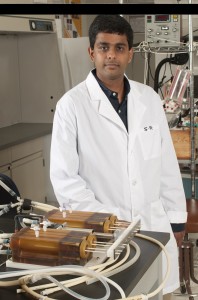 Sharan Ramaswamy, Assistant Professor of Biomedical Engineering, and his co-inventor team received a U.S. patent for their novel bioreactor for use in mechanobiological studies of engineered tissues. Ramaswamy’s bioreactor is designed for dynamically culturing engineered tissues across physiologically-relevant scales of flow, cyclic stretch and cyclic flexure, or any combination of these states. In other words, the bioreactor can replicate mechanical stresses of flow alone, or coupled with flexure and/or stretch states, that cardiovascular tissues would experience in vivo under normal or diseased states.
Sharan Ramaswamy, Assistant Professor of Biomedical Engineering, and his co-inventor team received a U.S. patent for their novel bioreactor for use in mechanobiological studies of engineered tissues. Ramaswamy’s bioreactor is designed for dynamically culturing engineered tissues across physiologically-relevant scales of flow, cyclic stretch and cyclic flexure, or any combination of these states. In other words, the bioreactor can replicate mechanical stresses of flow alone, or coupled with flexure and/or stretch states, that cardiovascular tissues would experience in vivo under normal or diseased states.
The device is compact and able to fit in a standard incubator. Several studies with this device are thus possible, with the intent of elucidating cell and tissue responses to these mechanical environments, which are highly relevant to cardiovascular regenerative medicine and cardiovascular disease. An added novel feature of this bioreactor is that it is MRI compatible, thereby permitting the noninvasive and nondestructive longitudinal monitoring of cell and tissue growth.
The idea was first developed in 2008, while Ramaswamy was working at the University of Pittsburgh. The six-year process has culminated in the invention of a device that could help answer several questions of interest in the context of cardiovascular mechanobiology. Ramaswamy affirms, “We have developed an adaptable device that can re-create a variety of sub-physiological, physiological, and supra-physiological stresses that engineered cardiovascular and valvular tissues may encounter during blood flow.”
At Florida International University, Ramaswamy and his students use the device regularly (Tissue Engineered Mechanics Imaging and Materials Laboratory/TEMIM Lab). He sees great potential in the device and research is ongoing in his lab. One example involves applying specific mechanical stresses onto bone marrow stem cells which can lead to differentiated cells and engineered heart valve tissues that recapitulate native valve cell and tissues properties respectively. Ramaswamy expects these important findings to be published next year (2015).
For more information on Ramaswamy’s research and his patent, please visit https://cvpeutics.fiu.edu
